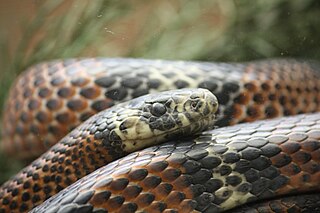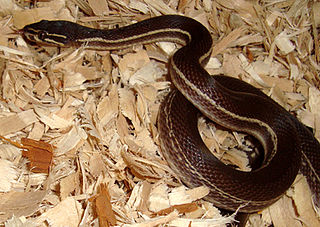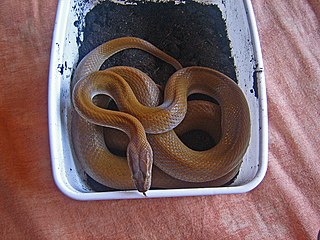
The milk snake or milksnake, is a species of kingsnake; 24 subspecies are currently recognized. Lampropeltis elapsoides, the scarlet kingsnake, was formerly classified as a 25th subspecies, but is now recognized as a distinct species. The subspecies have strikingly different appearances, and many of them have their own common names. Some authorities suggest that this species could be split into several separate species. They are not venomous to humans.

The Aesculapian snake, is a species of nonvenomous snake native to Europe, a member of the Colubrinae subfamily of the family Colubridae. Growing up to 2 metres (6.6 ft) in length, it is among the largest European snakes, similar in size to the four-lined snake and the Montpellier snake. The Aesculapian snake has been of cultural and historical significance for its role in ancient Greek, Roman and Illyrian mythology and derived symbolism.

Tantilla is a large genus of harmless New World snakes in the family Colubridae. The genus includes 66 species, which are commonly known as centipede snakes, blackhead snakes, and flathead snakes.

Rhabdophis is a genus of snakes in the subfamily Natricinae of the family Colubridae. Species in the genus Rhabdophis are generally called keelback snakes, and are found primarily in Southeast Asia.

Lampropeltis triangulum andesiana, commonly known as the Andean milksnake, is an alpine subspecies of milk snake.

Cemophora coccinea copei, commonly known as the northern scarlet snake, is a subspecies of harmless colubrid snake that is native to the southern and eastern United States.

Lithodytes is a genus of frogs in the family of Leptodactylidae. It is monotypic, being represented by the single species, Lithodytes lineatus, also commonly known as the gold-striped frog or painted antnest frog. It is found in tropical South America where it lives in humid forests among the leaf litter. These frogs build foam nests at the edge of temporary pools, and the tadpoles develop within these. The frogs also associate with certain leafcutter ants and breed inside their nests without being attacked by the ants.

Coronella girondica, commonly known as the southern smooth snake or Riccioli's snake, is a species of harmless snake in the family Colubridae. The species is endemic to southern Europe and northern Africa. No subspecies are recognized as being valid.

The Italian Aesculapian snake is a species of snake in the Colubridae family.

Cyclocorus is a genus of cyclocorid snakes endemic to the Philippines. They are found on every major island except for those of the Palawan chain.

Boaedon is a genus of African lamprophiids consisting of the "brown" house snakes. The genus was originally described by Duméril but the species contained were reclassified as Lamprophis by Fitzinger in 1843, this taxonomy remained widely accepted until November 2010 when a phylogenetic study was published by C.M.R Kelly et al. who resurrected the Boaedon clade. Although commonly regarded as belonging to the Colubridae, primary literature usually lists them, and related species, as belonging to the family Lamprophiidae within the superfamily which includes the venomous cobras and mambas, Elapoidea.

Boaedon capensis, the Cape house snake, also known as the brown house snake, is a species of lamprophiid from Botswana, South Africa, Mozambique, Zambia and Zimbabwe. They are a non-venomous lamprophiid. This species was previously grouped in the genus Lamprophis but is regrouped with the genus Boaedon.

The Lamprophiidae are a family of snakes found throughout much of Africa, including the Seychelles. There are 89 species as of July 2022.

The red-shouldered hawk is a medium-sized buteo. Its breeding range spans eastern North America and along the coast of California and northern to northeastern-central Mexico. It is a permanent resident throughout most of its range, though northern birds do migrate, mostly to central Mexico. The main conservation threat to the widespread species is deforestation.

Lamprophiinae is a subfamily of lamprophiid snakes, a large group of mostly African snakes, most of which were formerly classified as colubrids but which we now know are actually more closely related to elapids.

The Ezo chipmunk is a subspecies or local population of the Siberian chipmunk; it is found in what was once known as Ezo, namely Hokkaidō, Japan, and Sakhalin and the Southern Kuriles, Russia.














